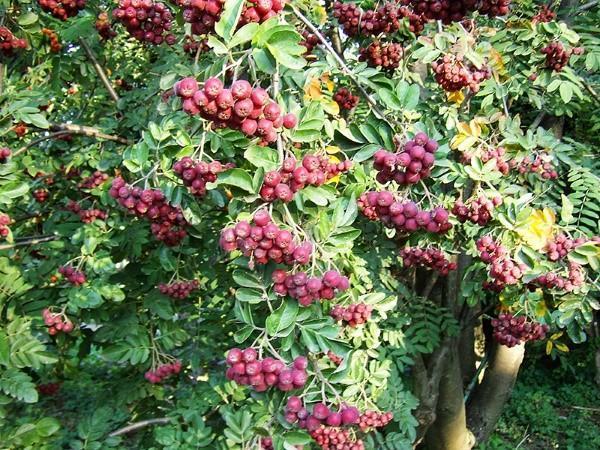Rowan pomegranate - a delicious dessert variety for real gourmets
 Even our grandmothers always knew that rowan berries become sweet and lose their astringency only after the first frost. But there is one variety that can be consumed already in September - this is the pomegranate mountain ash. It is not for nothing that it is recognized as a dessert, because dark red berries do not need to wait for frost. They are very tasty and sweet in themselves, and they are also large. That's what you really need to plant in the garden. What is this variety and does it have any special requirements for growing?
Even our grandmothers always knew that rowan berries become sweet and lose their astringency only after the first frost. But there is one variety that can be consumed already in September - this is the pomegranate mountain ash. It is not for nothing that it is recognized as a dessert, because dark red berries do not need to wait for frost. They are very tasty and sweet in themselves, and they are also large. That's what you really need to plant in the garden. What is this variety and does it have any special requirements for growing?
The variety is hybrid, and its parents are Nevezhenskaya mountain ash and hawthorn. The famous breeder Michurin bred a hybrid.
Description of culture
Pomegranate rowan is a culture with increased winter hardiness, which was transmitted to it from hawthorn... This makes it possible to grow perennials even in the most northern regions. It grows in the form of a short tree no more than 4 m tall and lives up to a maximum of 25 years. The tree has a dense rounded crown, while in most species of mountain ash, the crown has a columnar shape. The leaves are large enough, dark green, up to 12 cm long and about 6 cm wide. Rowan blooms in early summer, dissolving delicate white inflorescences with a barely noticeable pinkish tinge.
The dessert variety also differs from the common mountain ash in its berries. In young specimens, they are tied at the base of fruit twigs, and in adults, on ringlets. The latter live no more than 5 years. As already noted, the berries have a sweet, pleasant taste, and the bitter-sour note is not so pronounced. The berries themselves are very large, ripen at the end of summer and are ready to be harvested as soon as they gain a rich burgundy color. The peel on the berries has a characteristic bluish bloom.
Up to 20 kg of harvest can be harvested from one adult mountain ash, and the first berries are tied as early as 4 years after planting the seedling.
Rowan pomegranate: cultivation features
An unpretentious dessert variety is able to grow with minimal intervention from a gardener, if you choose the right planting site. It is better to plant rowan in the sun, as the yield drops sharply in the shade. Preference should be given to wet loamy soils, however, mountain ash will not grow in a swamp.
Tree care includes:
- Regular watering, especially if there is no rain, and loosening the near-stem circle after it.
- Formation. The rowan "makes" the crown itself, the only thing that is needed is to thin it out periodically. So the ovary will be larger, and the berries themselves will be larger. In young trees, branches should be shortened in early spring to stimulate branching.
- Top dressing. The first three years of life, mountain ash needs to be fertilized only in the spring, adding urea for digging. Older trees need to add autumn feeding with potassium-phosphorus preparations.
- Preventive treatment. One of the significant disadvantages of the variety is its weak resistance to diseases and pests. To protect the future harvest, you should spray the tree in the spring.
Although pomegranate is self-fertile, it is worth taking care of cross-pollination to maintain yields. To do this, you can plant Sorbinka or Dessertnaya rowan nearby.
Pomegranate mountain ash reproduces exclusively in a vegetative way. If you plant the seeds of a hybrid, then the new plants will not retain its quality.Therefore, it is necessary to propagate the culture either by grafting on mountain ash, or by green cuttings.